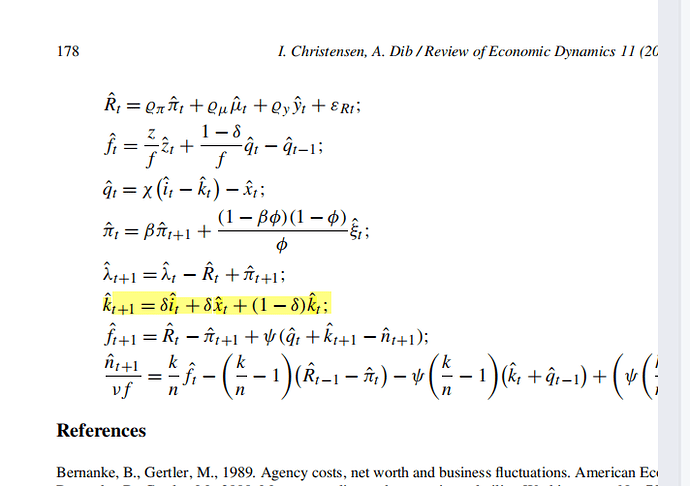Hi everyone, I am a student in DSGE.
I feel confuse about the linear version of a fomular.
Here is the orginal formular: (1-AC=1 in the dynare code)

I found that the dynare code writted by the author is:
i_h = k_h-(1-delta_h)*k_h(-1);
but the code is model(linear).
I think the correct version of log-linearize is:
i_h * Ihss = k_h*Khss-(1-delta_h)*k_h(-1)*Khss;
Because the setting of the steady state is not equal to 1, so I think the ‘ss’ should be added to the log-linearized version.
Here is the orginal code:
nk2c0100.mod (6.8 KB)
The code I am talking about is in line 99, ‘aa’ and ‘fs’ is parameter which can be ignored.
Here is the code changed by me, I add ‘ss’ into the code:
nk2c0101.mod (7.1 KB)
The code I am taliking about is in line 106, after doing so ,I found the IRF is changed. The effect of the shock was reduced.
Could anyone tell me which log-linearized version is correct?
Thank you very much!
You are right that with additive equations, the steady state values should generally show up. Thus, the first version is usually incorrect.
Thanks for your reply, professor jpfeifer!
I also found that the log-linearized version of the orginal version also used in the following paper, as is showed in the following picture:
Here is the paper:
christensen2008BGG.pdf (1.9 MB)
//So, I think the orginal log-linearized version made some sense, maybe? Because other authors can use this way to write papers.
//And I found that use different ways of log-linearized will provide different IRF, as is showed of the result of the .mod file above. If both ways are reasonable, which result should I believe?
Once again, thanks for your help. Merry Christmas!
Have a look at your linearization:
i_h * Ihss = k_h*Khss-(1-delta_h)*k_h(-1)*Khss;
Divide both sides by Khss:
i_h * Ihss/Khss = k_h-(1-delta_h)*k_h(-1);
and realize that \delta=\frac{I}{K} such that
i_h * delta = k_h-(1-delta_h)*k_h(-1);
which is identical to Christensen/Dib, but inconsistent with a linearization without a prefactor.
Thanks for your reply, best wishes to you!
And I have the other question:
If I change the fomular:
i_h = k_h-(1-delta)*k_h(-1);
into
i_h*(1-tax) = k_h-(1-delta)*k_h(-1);
(tax is a parameter)
Dose the log-linearize version of
i_h*(1-tax) = k_h-(1-delta)*k_h(-1);
still
i_h * (1-tax) * delta = k_h-(1-delta)*k_h(-1);
?
In others words , does the fomula σ=I/K still apply after I changed the fomula?
Thank you very much!
No. i_h*(1-tax) = k_h-(1-delta)*k_h(-1) implies \frac{I}{K}=\frac{\delta}{1-\tau}

